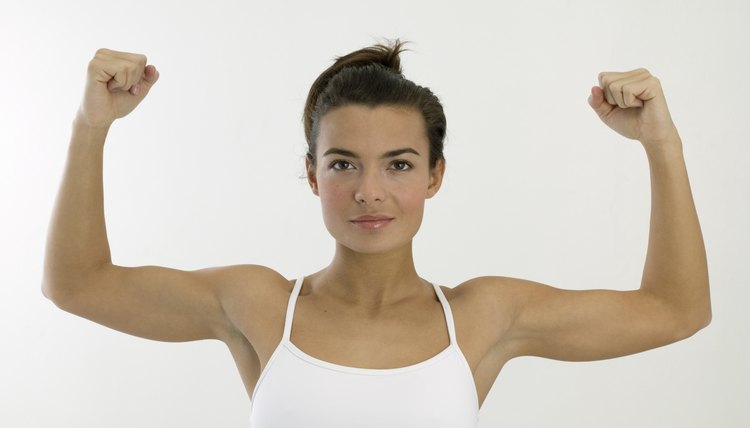Examples of Push & Pull Exercises

Push and pull exercises are critical elements of every training regimen, and neglecting either one can lead to postural problems, muscle imbalances and increased risk of injury. Compound push and pull exercises are particularly important exercises. Unlike isolation exercises, which require only a single joint movement, compound push and pull exercises activate more muscle fibers with multiple joint articulations. Most training regimens should incorporate both torso and lower-body compound push and pull exercises, because they work all major muscle groups.
Torso Push
Torso-pushing exercises include horizontally and vertically loaded movements. Horizontally loaded torso-pushing exercises, including the flat, incline and decline variations of the bench press, target the pectoral and anterior deltoid muscles. Vertically loaded torso-pushing exercises target the lateral deltoid and trapezius muscles. Examples of vertically loaded torso-pushing exercises include free-weight and machine variations of the military press and shoulder press. Both horizontally and vertically loaded torso-pushing exercises also activate the serratus muscle, with vertically loaded exercises emphasizing the lower serratus muscle fibers.
Torso Pull
Torso-pulling exercises include horizontally and vertically loaded movements that work the posterior side of your torso. Horizontally loaded torso-pulling exercises target the trapezius, posterior deltoids, latissimus dorsi and rhomboid muscles. Examples of horizontally loaded pulling exercises include seated rows, dumbbell rows, T-bar rows and bent-over rows. Vertically loaded pulling exercises target the latissimus dorsi, levator scapulae, upper pectoral and biceps muscles. Chinups, pullups and lat pulldowns are examples of vertically loaded torso-pulling exercises.
Lower-Body Push
Lower-body pushing exercises include vertically and horizontally loaded movements. Single and double-leg vertically loaded pushing exercises work the quadriceps, adductor magnus and soleus muscles. Double-leg vertical-pushing exercises include squats and leg presses; single-leg vertical pushing exercises include lunges and split squats. Horizontally loaded lower-body pushing exercises target the gluteus maximus, hamstring and calf muscles. Examples of horizontal lower-body exercises include hip thrusts and glute bridges, which extend your hips against frontal resistance.
Lower-Body Pull
Lower-body pulling exercises emphasize hip extension and knee flexion movements. Hip extension leg-pulling exercises activate the gluteus maximus, hamstrings and adductor magnus muscles. Examples of hip extension lower-body pulling exercises include deadlifts, reverse hyperextensions, good-mornings and pull-throughs. Knee flexion lower-body pulling exercises activate the hamstrings, hip adductors, sartorious and calf muscles. Lying, seated and standing leg curls are examples of lower-body pulling exercises that flex your knees. Exercises that combine hip extension and knee flexion include glute-ham raises and kneeling hip extensions. Rolling, sliding and gliding leg curls also combine knee flexion and hip extension.
References
Resources
Writer Bio
Miguel Cavazos is a photographer and fitness trainer in Los Angeles who began writing in 2006. He has contributed health, fitness and nutrition articles to various online publications, previously editing stand-up comedy and writing script coverage as a celebrity assistant. Cavazos holds a Bachelor of Arts in philosophy and political science from Texas Christian University.
